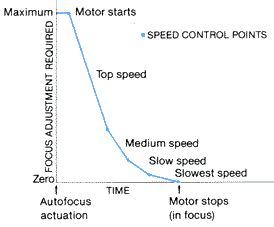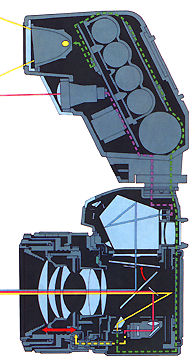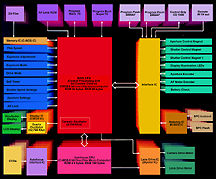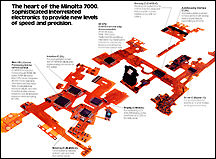 |
|
The Minolta 7000's autofocus system is not an "add on" system employing an external motor drive, motorized lenses or converters. Instead, the autofocus sensors, motor and microcomputers are self-contained within the Minolta 7000's slim, styled body.
Update: "Jonky Tambayong" <yonky@cbn.net.id > Wrote: " ....This Photography Website is very good , I am sure many has learned and enjoyed from this site like myself , I have a Minolta Maxxum 7000 and while browsing for info regarding this camera I came upon your site , Thank you for sharing so much quality information , I would like to inform you that in the picture from your site I herewith attached of the maxxum7000 , the internal Lithium battery with the M ( Matsushita ) logo the plus + side is facing outwards to the metal plate , I believe it must be facing inwards , so the NEGATIVE side is facing up . I noticed this while looking for info to replace the lithium battery in my camera . Thanks again ...." This is his scanned image (in PDF file 334k)
A ROM IC built into each Minolta AF lens supplies data for autofocusing and transfers this essential information to the camera's CPU through electrical contacts on the Minolta 7000's revised lens mount. In this way, lens and camera weight and size are minimized; balance and control are excellent; handling and operation are far easier. It is truly an integrated system... you'll feel the difference immediately!
  |
![]() Thanks to its highly
electronicalized camera body and "intelligent" system accessories, the
Minolta 7000 provides an extremely flexible total SLR system capability. At the heart
of the Minolta 7000 are six ICs and two 8-bit CPUs ... the equivalent of 150,000
transistor circuit.
Thanks to its highly
electronicalized camera body and "intelligent" system accessories, the
Minolta 7000 provides an extremely flexible total SLR system capability. At the heart
of the Minolta 7000 are six ICs and two 8-bit CPUs ... the equivalent of 150,000
transistor circuit.
n essence, then, the Minolta 7000 acts as a "host computer", with system accessories interfacing as "satellite computers" This synergistic systemization can thus respond instantaneously to the ongoing photographic situation to provide optimum photographic results. Download a Copy of PDF file (284k) of this diaphragm
Download a Copy of PDF file (368k) of this diaphragm
 |
|
Phase detection focusing monitors the distance between the two images projected on the CCD and the camera's CPU instantly calculates both the focusing direction and the amount of lens movement necessary to bring the lens to its in-focus position. And the autofocus sensoring operates down to EV 3 (at ISO 100). An extremely high level of accuracy is gained by use of this phase-detection focusing system, in addition to an excellent response time.
![]() The Minolta 7000 uses another technologically-advanced
system to assist in speedily and accurately positioning the lens for autofocusing.
As soon as the in-focus position has been determined by phase detection focusing,
the amount of micro motor rotation required to move the lens for sharp focus is instantly
calculated by the onboard AF microcomputer.
The Minolta 7000 uses another technologically-advanced
system to assist in speedily and accurately positioning the lens for autofocusing.
As soon as the in-focus position has been determined by phase detection focusing,
the amount of micro motor rotation required to move the lens for sharp focus is instantly
calculated by the onboard AF microcomputer.
 |
Each rotation of the micro motor that drives the lens is broken down into sixteen pulses by a special digital encoder and as the lens approaches the-n-focus position, the micro motor's rotation is slowed by a four-step rotation control and then stopped at precisely the right position. Direct digital control has a tremendous advantage over conventional SLR autofocus systems in speed, in addition to being, accurate and smooth. |
![]() The Minolta 7000's high-tech Autofocus
System keeps on working even in low light or total darkness. With the Program Flash
2800AF attached to the camera's accessory shoe, autofocusing even in total darkness
is possible up to five meters away*.
The Minolta 7000's high-tech Autofocus
System keeps on working even in low light or total darkness. With the Program Flash
2800AF attached to the camera's accessory shoe, autofocusing even in total darkness
is possible up to five meters away*.
 |
With low-contrast subjects in low light, when the camera's operating button is pressed halfway, the flash's AF illuminator releases a burst of near-infrared light. The 7000's high-tech Autofocus System uses this light to make a single measurement and to adjust focus. Just before shutter release, a second near-infrared burst from the AF illuminator confirms that focus is correct. |
![]()
Specification | Main
Reference Map
First Generation Minolta
AF Lenses
Minolta XD-7/XD-11 |
Minolta XK/XM/X-1 |
Minolta X-700 |
Maxxum
7000
| Maxxum 7000i
| Message
Board
| for Minolta X-700 | Maxxum 7000
| Maxxum 7000i
| Message
Board
| for
your Minolta optics in a shared environment
| Message
Board
| Specifically
for Dispose or
Looking for
Minolta Photographic Equipment
Other Minolta
(now Konica-Minolta) resources on the web:
Free
Instruction
Mannuals
in PDF format downloads for:
Minolta
X-370 (300) (2.9 MB) | Minolta X-570 (1.9 MB) | Minolta XG-1 (1.8 MB) | Minolta XG-7 (1.5 MB) | Minolta XG-A (1.8 MB) | Minolta XG-M (1.9 MB) | Minolta
SR7
(1.5 MB) | Minolta SR-T (7.0 MB) | Minolta SR-T 102 (1.8 MB) | Minolta SR-T 200/201/202 (2.8 MB) | Minolta SR-T 303 (1.7 MB) | Other
models & system accessories
(USA) All works courtesy of Mr. Jim, lensinc. Ltd. Thank him, as these are not
my effort.
About this photographic site.
Home - Photography in Malaysia |
Credit: Mr Aaron Oh, for lending his old Maxxum 7000 brochure to prepare certain content appeared in this site; LEONID.SL<leonid.sl@prodigy.net> for his great image of the Maxxum 9000; Johannes Huntjens <yawngie@msn.com>, LT Jack B. Nunley <jnunley@insightbb.com> and "Jarret LaMark" <jlamark@wbhunt.com> huntsphotoandvideo.com for their generosity for granting permission to use some of the Maxxum 7000 images appeared in this site; Lapapl@aol.com for his image of the Minolta Maxxum 7000 AF Body / Program Back 70;"Camera Works" <cameraworks@qwest.net> for some superb view of the camera; Dan Dorsey <Fotowv123@cs.com> for his shots of the 7000 Body w/ Org. Box & Manual; "Rehmat Iqbal" <mimifour@hotmail.com><srafiq@houston.rr.com> for being so considerate and helpful. Certain content and images appeared in this site were either scanned from official marketing leaflets, Instruction Manual(s) & brochures published by Minolta and/or contribution from surfers who claimed originality of their work for educational purposes. The creator of the site will not be responsible for may discrepancies arise from such dispute except rectifying them after verification. "Minolta", "Rokkor", "X-700", "Dynax" & "Maxxum" are registered trade names of Minolta Optical Inc., Japan. A site dedicated to all Minolta fans worldwide. Site made with an Apple IMac.


